Facebook has updated the ads reporting tool — a tool most advertisers don’t know even exists — to be incredibly useful.
The new tool allows you to quickly determine how a single ad performed by age, country and placement without having to split test with multiple ads. It also allows you to evaluate the performance of your ad based on Action metrics (conversions, for example) and cost per that action.
Go to facebook.com/ads/manage/reporting.php to access your reports.
If it looks like this…
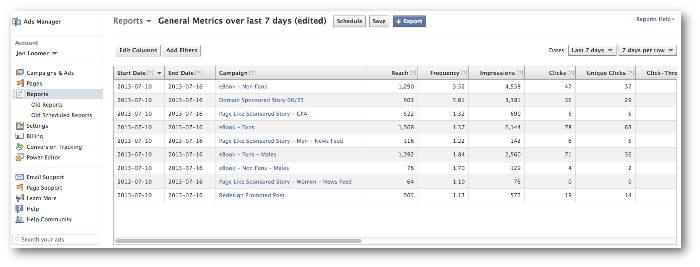
…it’s your lucky day! You have the new Facebook ad reports.
If it looks like this…

…sorry! You still have the old Facebook ad reports. You’ll need to wait for the new ones to be rolled out to you.
Regardless of whether or not you have the new Facebook ad reports yet, I’ve written this post to help you understand all of the awesome new features available within it.
This will be a top-level overview. I’ll write other posts in the future to provide more hands-on examples of how it can be used.
Edit Columns
One of the most exciting pieces of this new tool is the ability to edit precisely what information you want to be shown in a Facebook ads report.
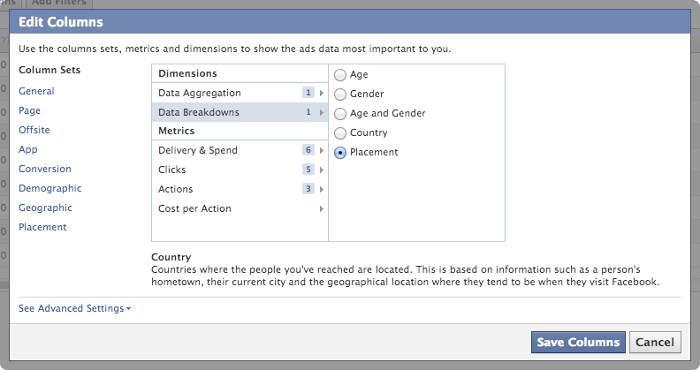
With the Edit Columns feature, for example, you could compare the performance of ads based on the following:
- Placement of the Ad (News Feed, Desktop, Mobile, Sidebar)
- Gender
- Country
- Cost Per Page Like
- Cost Per Website Conversion
You couldn’t view all of these within the same report, but they are all available and extremely valuable.
Following are all of the various columns that are available to you…
Dimensions – Data Aggregation
This allows you to easily evaluate which campaigns or ads, for example, performed best. Probably best to at least keep the name of the ad within a column.
- Account
- Campaign
- Ad
- Account ID
- Campaign ID
- Ad ID
Dimensions – Data Breakdowns
Possibly the most exciting inclusion in this tool. You can only choose one of these per report, but this allows you to easily compare the Cost Per Action, for example, of ads based on age, gender, country and placement.
For example, you could create one ad that targets all placements. Then create a report to compare your Cost Per Action for Desktop News Feed, Mobile News Feed, All Desktop and the Desktop Sidebar.
With this information, you could then stop that original ad and then start a new one that uses those optimized specs.
I’m most excited about this because I notoriously create dozens of ads in my split testing to help determine this. It’s no longer completely necessary (split testing is still important for copy and imagery, however).
- Age
- Gender
- Age and Gender
- Country
- Placement
Metrics – Delivery & Spend
Include columns for the metrics you feel are important. In my opinion, most important here is Spend to keep other results relative.
- Reach
- Frequency
- Impressions
- Social Reach
- Social Impressions
- Cost Per 1,000 Impressions (CPM)
- Cost Per 1,000 People Reached
- Spend
Metrics – Clicks
Personally, I’m not particularly concerned about general clicks. You can select as many of these as you want. I tend to keep all unselected.
- Clicks
- Unique Clicks
- Social Clicks
- Click-Through Rate (CTR)
- Unique Click-Through Rate (uCTR)
- Cost Per Click (CPC)
- Cost Per Unique Click
Metrics – Actions
This is the good stuff! This is what determines success and failure of your campaign. Now, you may, however, want to skip this section and go directly to “Cost Per Action.” But including at least one of these columns could be important for perspective.
In general, you can select columns for:
- Actions
- People Taking Action
These actions can then be broken down by those associated with your Facebook Page, External URL, Application or Event.
If you create ads that drive users to an offsite landing page that drives some sort of conversion with an offsite pixel (purchase, lead, add to cart, etc.), this is extremely useful!
Facebook Page:
- Page Likes
- Page Engagement
- Post Engagement
- Post Likes
- Post Comments
- Post Shares
- Page Photo Views
- Page Video Plays
- Link Clicks
- Offer Claims
- Check-ins
- Page Mentions
- Page Tab Views
- Question Answers
- Question Follows
External URL:
- Website Conversion
- Checkouts (Conversion)
- Registrations (Conversion)
- Leads (Conversion)
- Key Web Page Views (Conversion)
- Add To Carts (Conversion)
- Other Website Conversions
Applications:
- App Installs
- Mobile App Installs
- App Engagement
- App Story Engagement
- App Uses
- Credit Spends
- Mobile Purchases
Events:
- Event Responses
Metrics – Cost per Action
This is where you make and save money. For me, the true measure of success of an ad campaign comes down to Cost per Action.
Once again, this is broken down by actions associated with your Facebook Page, External URL, Application or Event.
Facebook Page:
- Cost per Page Like
- Cost per Page Engagement
- Cost per Post Engagement
- Cost per Post Like
- Cost per Post Comment
- Cost per Post Share
- Cost per Page Photo View
- Cost per Page Video Play
- Cost per Link Click
- Cost per Offer Claim
- Cost per Check-in
- Cost per Page Mention
- Cost per Page Tab View
- Cost per Question Answer
- Cost per Question Follow
External URL:
- Cost per Website Conversion
- Cost per Checkout (Conversion)
- Cost per Registration (Conversion)
- Cost per Lead (Conversion)
- Cost per Key Web Page View (Conversion)
- Cost per Add To Cart (Conversion)
- Cost per Other Website Conversion
Applications:
- Cost per App Install
- Cost per Mobile App Install
- Cost per App Engagement
- Cost per App Story Engagement
- Cost per App Use
- Cost per Credit Spend Action
- Cost per Mobile Purchase
Events:
- Cost per Event Response
Ad Filters
You probably want to view only certain campaigns or certain ads within a campaign to keep any comparison relevant. For example, there’s no reason to compare a campaign aimed at getting Page Likes to one focused on offsite conversions.
So make sure you use your filters to select applicable ads and campaigns. You can create more than one filter if necessary…

Dates
Do you want to view performance only during a specific period of time? Make sure you select the applicable dates to compare here…
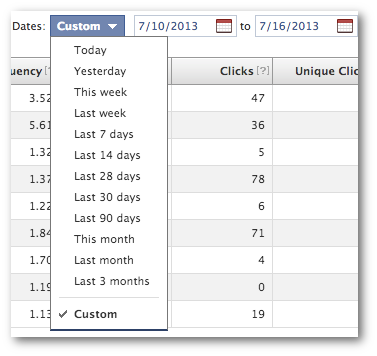
You can also determine how many days will apply to each row. Maybe you want all days to apply. But you can also break up an ad’s performance into seven day increments to see if it is trending in a positive or negative direction…
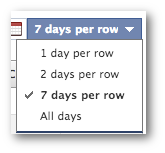
Schedule Reports
This is great for any advertisers who need to provide reports to clients or higher up — or for any advertiser who simply needs regular reminders regarding the performance of their advertising.
Choose how often these reports are generated and have alerts emailed to you when they are ready.
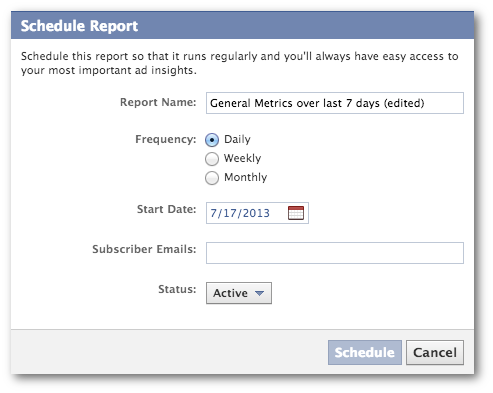
Save Report Settings
Do you have specific filters that you will use later? Save them! This is a great time saver.
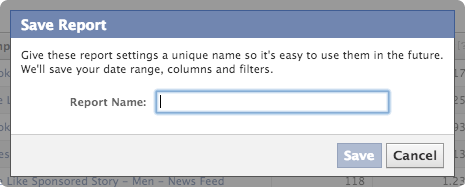
More to Come!
Have you tried out the new Facebook Ad Reporting yet? This is an exceptional tool that will only get better. I am still experimenting with it and will provide more posts in the future with specific use cases to leverage these reports for your success.
Let me know how you’re using them in the comments below!






